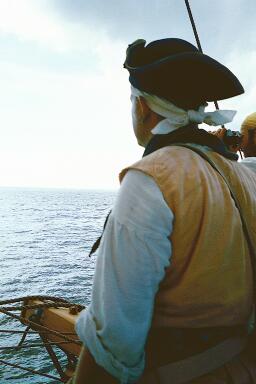Learn the Lingo
The Nautical Word of the Week
Being a Weekly Word (or Phrase)
Of a Nautical Nature

For the Week of March 14, 2004
Bow-chaser, chase or chase-piece.
A long gun with a relatively small bore, placed in the
bow-port to fire directly ahead. Used especially while
chasing an enemy vessel to damage its sails and rigging.
(quoted from A Sea of Words)
For the Week of March 7, 2004
Lay.
To come and go, used in giving orders to the crew, such
as "lay forward" or "lay aloft". To direct the course of
vessel. Also, to twist the strands of a rope together.
(quoted from A Sea of Words)
For the Week of February 29, 2004
Chain-wale or channel.
A broad, thick plank that projects horizontally from each of
a ship's sides abreast a mast, distunguished as the fore, main,
or mizzen channel accordingly, serving to extend the base for
the shrouds, which supports the mast.
(quoted from A Sea of Words)
For the Week of February 22, 2004
Quay.
An artificial bank or landing place, usually built of stone,
alongside or parallel to a navigable water for loading and
unloading ships. When projecting into the water as a
breakwater and a landing place, it is also known as a mole.
In later American usage, this is also called a pier, but in
England in the late 18th century, a pier was normally a
quay protecting the entrance of a river, harbor, etc.
(quoted from A Sea of Words)
For the Week of February 15, 2004
White-ash breeze.
The current of air created when a boat is rowed
in a dead calm. Ash is the best wood for oars.
(quoted from Sea Language Comes Ashore)
For the Week of February 8, 2004
Mackeral sky.
Mottled cirrus clouds foretelling a change of weather.
Mackeral skies and mare's tails
Make tall ships carry low sails.
(quoted from Sea Language Comes Ashore)
For the Week of February 1, 2004
Orlop deck.
The lowest deck of a ship, lying on the beams of the hold and named
from
the Dutch word for “overlap” because it overlaps the hold. The ship’s
cables
and supplies were stored on the orlop deck, and the purser and carpenter
often had offices here, near their supplies. Below the waterline, this
was also the
site of the powder magazine, and sometimes the stuffy quarters for
gunners,
boatswains, carpenters, and midshipmen. Originally, the orlop deck
was the
single floor or deck covering the hold of a ship; with the additions
of decks
above, the orlop became the lowest deck of a ship of the line and was
not
usually called a “deck.” When a ship had two complete levels these
were
called orlop and deck; when three floors, they were orlop, lower, and
upper deck; when four floors, orlop, lower, middle, and upper deck.
(quoted from A Sea of Words)
For the Week of January 25, 2004
Holystone.
A soft sandstone used by sailors for scouring the decks of ships, after
which the
deck was hosed down with saltwater, creating a smooth, blanched appearance.
Small holystones were called prayer books and large ones bibles. The
provenance
of the terminology is unknown; the theories range from the possibility
that the stones
were first taken from the broken monuments of St. Nicholas Church in
Great
Yarmouth to the fact that sailors often scrubbed the deck on their
hands and knees.
(quoted from A Sea of Words)
For the Week of January 18, 2004
Hell to pay.
The complete phrase is "Hell to pay and no pitch hot!" from
the shipbuilding operation of filling the seams of the deck with
hot pitch after caulking. It has been stated that "hell" was a
name for the seam next to the waterway, because it was difficult
to work on; but it seems more likely that a lively imagination
conceived the difficulties of paying the seams of Hell itself.
(quoted from Sea Language Comes Ashore)
For the Week of January 11, 2004
Every hair a rope-yarn and every drop of his blood Stockholm tar.
A seaman's description of a thorough seaman.
(quoted from Sea Language Comes Ashore)